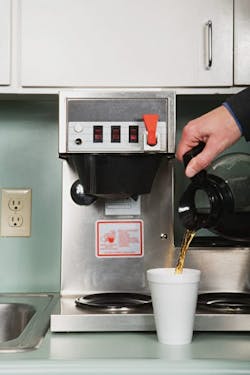Plant engineering had done much to reduce energy waste at a manufacturing facility. Among the measures taken:
• Upgrading lighting to more efficient systems (originally, they had magnetic ballast lighting throughout the facility).
• Installing auto-dimming systems for lighting; these use occupancy sensors, daylight sensors, and timers.
• Tightening up the building envelope. Using thermography, workers were able to locate and mitigate leaks.
• Upgrading heating systems to more efficient designs, including the addition of heat pump technology.
• Upgrading larger motors to energy-efficient design motors.
• Installing variable-speed drives on motors that had been using gearboxes for speed reduction.
The company also installed a small wind power unit and outfitted one building with a solar array. The managers were very proud of what they had accomplished. A lot of thinking went into these improvements.
But it was a junior member of the janitorial staff who identified a source of energy waste they had never noticed. In the administration building, many things were left running overnight. These included, on occasion, a row of coffee pots (nasty gunk by morning!).
Every work station or cubicle had at least one task light. For two weeks, the janitor noted how many of those were left on each night; it was more than half.
What really bothered the janitor was seeing all the computers left on. And logged in. He stopped by the plant engineer’s office before leaving and shared what he had observed.
The plant engineer thought about putting the office branch circuits on some sort of timer control, so people could go home and not have to worry about whether they had left something on.
But he knew that shutting off a Windows computer without going through the Windows shutdown could cause all sorts of headaches. And someone might be staying late to finish a project. That person would not appreciate losing power just before clicking on "save." Shutting off that person’s task light wouldn’t be good, either.
So the plant engineer talked with some people in the office to get their take on the situation. The people he spoke with just hadn’t stopped to think about shutting things off.
Rather than a technology solution, his solution was to go back to the people he surveyed and ask them to spread the word about shutting off the task lights and the computers before going home for the day. And he had one of the mechanics make a “shut us off” sign to place by the coffee pots. The problem basically went away.
The lessons here? Look (and listen) outside your normal environment (in this case, the day shift) for energy waste. And sometimes, a people solution works as well as, if not better, than a technology solution.
And there’s a third lesson: Talk to people so you can figure out which mix of people solution and technology solution will work best.
About the Author

Mark Lamendola
Mark is an expert in maintenance management, having racked up an impressive track record during his time working in the field. He also has extensive knowledge of, and practical expertise with, the National Electrical Code (NEC). Through his consulting business, he provides articles and training materials on electrical topics, specializing in making difficult subjects easy to understand and focusing on the practical aspects of electrical work.
Prior to starting his own business, Mark served as the Technical Editor on EC&M for six years, worked three years in nuclear maintenance, six years as a contract project engineer/project manager, three years as a systems engineer, and three years in plant maintenance management.
Mark earned an AAS degree from Rock Valley College, a BSEET from Columbia Pacific University, and an MBA from Lake Erie College. He’s also completed several related certifications over the years and even was formerly licensed as a Master Electrician. He is a Senior Member of the IEEE and past Chairman of the Kansas City Chapters of both the IEEE and the IEEE Computer Society. Mark also served as the program director for, a board member of, and webmaster of, the Midwest Chapter of the 7x24 Exchange. He has also held memberships with the following organizations: NETA, NFPA, International Association of Webmasters, and Institute of Certified Professional Managers.

